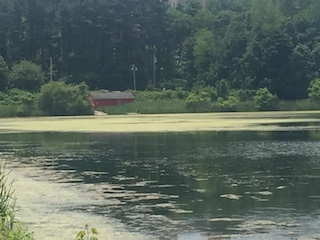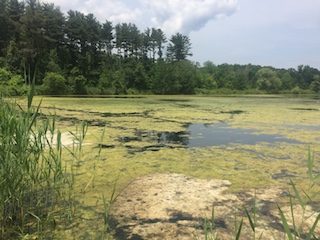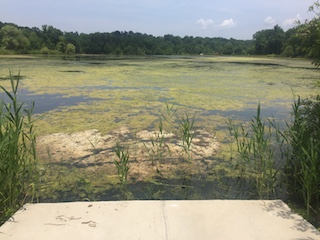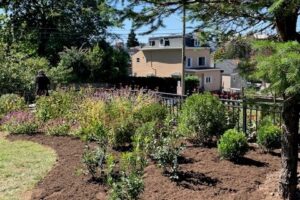 At some point in their education, schoolchildren learn that close to three quarters of the earth’s surface is composed of water. Textbooks also tell students that 97% of the water comes from oceans and seas, and that lakes – those natural and man-made jewels that dot landscapes – comprise less than 1% of the total amount of water on the planet. Of course, adults generally forget what they learned in school. And, once they forget how scarce lakes are, they also, most likely, forget how easy it is for those lovely oases of calm to lose their pristine blush and descend into degradation.
At some point in their education, schoolchildren learn that close to three quarters of the earth’s surface is composed of water. Textbooks also tell students that 97% of the water comes from oceans and seas, and that lakes – those natural and man-made jewels that dot landscapes – comprise less than 1% of the total amount of water on the planet. Of course, adults generally forget what they learned in school. And, once they forget how scarce lakes are, they also, most likely, forget how easy it is for those lovely oases of calm to lose their pristine blush and descend into degradation.
Two Man-made Lakes – One East, One West
Tarrytowners historically take enormous pride in their lakes, one smaller and towards the west; one larger towards the east. The man-made lakes were formed in the late 1880s, when a major fire made it apparent that the Village’s water supply was insufficient. Their creation is credited in part to a bond floated by Jay Gould, a name familiar to many through the Lyndhurst estate, his grand residence.
Yet, of the two beloved lakes, the smaller one is in trouble, as any passerby seeing the algae floating on the surface will be forced to attest – whatever fondness she may harbor for the lakes beside which people continue to jog, hike and bike, fish or sometimes paddle a kayak on.
Situated off the Saw Mill River Parkway’s Eastview Exit 23 (the Parkway exit is probably the only context wherein that name is still used), the lakes are located away from Broadway and Main Street with their multiple shops and restaurants and the waterfront parks that overlook the Hudson. The lakes were once beside the now extinct rail line that connected Brewster to the Bronx; tracks that were eliminated when the Hudson and Harlem lines became the prevailing means of transport.
Let’s turn the page to a separate chapter in the textbook on bodies of water, the one about the life cycle of lakes. In youth, they are fresh, clean, even sparkling. In middle age, the nutrients of stormwater runoff invariably cause plant growth and algae to encroach, threatening their health, their life. The book will add that degradation can be accelerated or slowed by human intervention. Ay, there’s the rub! If we finish the book, will we read that lakes decline into a murky and muddled old age – or will we find that science has discovered a way to correct the ravages, a sort of Botox fix for water?
A Village Determined to See Results
The good news is that Tarrytown is committed to preserving and restoring its treasured lakes. The bad news? So far, the best laid plans of . . . let’s just say, the efforts haven’t worked to date. Hmm. You ask, appropriately, “Why not? What exactly is the Village doing and why isn’t it seeing results?”
Tarrytown Village Manager Rich Slingerland explains that the application of copper sulfate to the large lake according to limits determined by the EPA is working and the lake is in good condition. Neither lake will be used for drinking water – there is no treatment plant and no need to create one as the amount of water would only supply a very small percent of what’s needed. Both lakes, he says, are safe for fishing and the New York State Department of Environmental Conservation stocks them with fish, largely sunfish and bass.
The small lake was dredged back in the 1980s, a process that removes sediment from the bottom, but unfortunately the benefits of that only lasted a short time, because the lake is going through a process called eutrophication, where nutrients from natural and manmade sources, like the woods and fertilized lawns from properties surrounding the lake, are contributing nutrient-rich materials. In turn, says Slingerland, “The lake is getting shallower and shallower over time, making it warmer which enhances the ability of algae blooms to grow.”
Slingerland says that Tarrytown’s Village government is very concerned about the condition of the Tarrytown Lakes. He tells River Journal that the Village has spent approximately $75,000 over the past five years, an average of around $15,000 a year.
“The health of the lakes,” he says, “has been a priority for many years. We’re looking into plans for a better and more useful future for the lakes and the amenities around them.”
He points out that he and other Village representatives attended a day-long seminar in December 2017 to learn about the latest means of controlling water plant and algae growth in lakes similar to Tarrytown’s small lake.
“Thus far the Village’s efforts have been to treat the western lake with more organic treatments. It is our plan to continue that approach, but perhaps with different or more aggressive methods,” says Slingerland. The treatments have been administered since 2011 by an environmental technology company based in Richland, Michigan, aptly named Lake Savers.
Lake Savers’ Multi-Pronged Strategy – Can It Work?
John Tucci, Lake Savers’ founder and president, who holds a geology degree from Amherst College, grew up in lake country. He started an experimental side business in his garage and, in 2007, made Lake Savers a full-time endeavor. The company, which has done projects nationwide, has a branch in Greentown, PA – less than two hours from Tarrytown – which performs the treatments at least once a month from April through October. The company uses a holistic, natural restoration method which, rather than destroying plant infestations with chemicals, attempts to bring back the ecosystem naturally and into balance.
Tucci explains that “lake health is all about controlling the fertilizers and nutrients that enter the lake and feed harmful weed and algae growth.”
For the Tarrytown lakes, Lake Savers has adopted a multi-pronged approach:
• A filtration system on the main inlet that cleans the water before it enters the lake. The hope was that it would “be the thing to help us turn the corner,” yet Tucci says with regret, “To our surprise it did not.” Amanda Wisner of the Greentown branch holds a Master’s degree in aquatic biology. She has analyzed the data collected from Tarrytown and assessed that the filtration system reduced phosphorus inputs (fertilizer) by more than 50%; apparently that hasn’t been enough to make a meaningful difference;
• An aeration system that circulates the water to avoid stagnation. This measure worked “extremely well” for the first two years, then backslided to such a degree that Lake Savers decided to forego charges for this component in 2017;
• A bio-blast or biological treatment system. Since so far only one treatment of this has been applied, this may turn out to be, if not the silver bullet, at least a hopeful step. Tucci explains that each time it’s applied it’s like building up the immune system;
• Use of colorants or dyes to darken the water making it more difficult for sunlight to penetrate, as water temperature plays a role in the preponderance of plant growth. First used in 2017, this year will be the first time it is used in combination with the bio-blast.
“We’re very optimistic that this program will help get us where we want to be,” says Tucci, then quickly adds “but we’ve been humbled.”
A Most Confounding Project
 He explains that any urban lake (in this context there’s no distinction between urban and suburban) poses “special challenges.” When paved surfaces are plentiful around a lake, stormwater runs along streets in “rivers” and dumps into the lakes. When streets are sparse in rural areas, water is absorbed by the ground. Urban lakes have high volumes that get collected and concentrated holding high amounts of phosphorous and nitrogen.
He explains that any urban lake (in this context there’s no distinction between urban and suburban) poses “special challenges.” When paved surfaces are plentiful around a lake, stormwater runs along streets in “rivers” and dumps into the lakes. When streets are sparse in rural areas, water is absorbed by the ground. Urban lakes have high volumes that get collected and concentrated holding high amounts of phosphorous and nitrogen.
Speaking with surprising candor, Tucci says, “These lakes have been a huge challenge for us . . . one of the most challenging projects faced since the company’s founding, one of the toughest and most confounding.”
“We’ve gathered a lot of data and applied the best science . . . [but we] couldn’t keep up with the nutrients. Nature is an intricate puzzle to work out.”
Can one point a finger of blame at anyone? Absolutely not, says Tucci, emphasizing that there is no villain to be found.
No Bad Guy to Be Found
“There is no bad guy in this story – the Village has worked hard to find a sound approach. We couldn’t ask for a better commitment.” He says too, “We’re very thankful for the partnership and ongoing commitment of the Village. They’ve stuck with us . . . even though we haven’t achieved the results we want.”
Tucci suspects that climate change is playing a role – noting that there have been many more multi-inch, heavy “gully washer” rainstorms in the last few years.
“The more ‘bad’ water, the more phosphorous and nitrogen. When you get a big heavy rain, that brown in the water is soil and nutrients that wash off the land – the more fertilizer gets in the lake, the more weeds and algae,” he says. Erosion of the soil pulls “all of the crude at a very fast rate and we haven’t been able to keep up.”
“Our track record and strategies we use are the most advanced in the nation. We haven’t been able to crack the code. We continue to try with more innovative strategies, we’re not happy until we achieve the results our customers expect.”
What about a chemical treatment strategy? He explains that would kill the plant growth, but build a septic compost pile on the bottom which would destroy the lake in the long term. Westchester towns that have chosen to pour chemicals into their lakes are “putting a band-aid on the problem.”
Isn’t money usually both the culprit – when withheld – and the solution, when spent? Not this time.
For Once, Money Isn’t the Answer
Says Tucci: “If Tarrytown spent more it wouldn’t solve the problem – if there was a sum of money that would fix the lakes it would be seriously considered. Quick fixes don’t work.” (So much for the Botox idea.) “The Village wants to know that there’s a good chance of success backed up by data.”
“If it were easy to restore lakes like this everyone would do it. New York State has devoted millions to combating harmful algae blooms – at least the algae here is not the harmful form.”
Ah, what about the surrounding homes – could they be to blame? Again, a resolute “no” from Tucci: “Don’t blame the neighborhoods – people are doing the right things. It’s just the infrastructure challenge of storm water flow. Higher frequency, higher flow storm water events.”
“Tarrytown has pushed us to never be complacent and is forcing us to develop new and better approaches to restoring lakes. We’re committed to getting the lakes back to a condition where they become a beautiful amenity for the community. We may not have the lakes perfect by the end of summer 2018, but we’ll know for sure if we can turn this thing around. I know I speak for the Village in saying that we can hold our heads high that we are doing all we can to save the lakes – we’ll keep trying.”
Ask Tucci for a deadline and he says, “We expect to see significant improvement in the next 30 to 45 days to see if we’re on the right track. If not, we’ll have the data to bring to the Village to hit the lakes even harder with the strategies and innovation to get us there next year.”
In the Meantime, Back at the Large Lake and Buildings…
 In the meantime, other improvements are being made on and around the lakes. Slingerland notes that kayaking continues on the large lake. Tarrytown residents may purchase an annual permit and bring their own kayak; non-residents can rent kayaks from a company that brings kayaks in on weekends. There are plans to demolish a red building known as the Skate Shack and build decks from which to fish and view the lake. The Village is seeking grants to fund this project. The Village is also negotiating a long-term lease with Duncan’s Abbey to rehabilitate and convert the obsolete pumping station on the east lake into a brewery. He notes too that in 2018 there were approximately 10 days when the lakes froze solid enough – 8 to 10 inches down – to allow skating.
In the meantime, other improvements are being made on and around the lakes. Slingerland notes that kayaking continues on the large lake. Tarrytown residents may purchase an annual permit and bring their own kayak; non-residents can rent kayaks from a company that brings kayaks in on weekends. There are plans to demolish a red building known as the Skate Shack and build decks from which to fish and view the lake. The Village is seeking grants to fund this project. The Village is also negotiating a long-term lease with Duncan’s Abbey to rehabilitate and convert the obsolete pumping station on the east lake into a brewery. He notes too that in 2018 there were approximately 10 days when the lakes froze solid enough – 8 to 10 inches down – to allow skating.
Of course, the restoration is the core of the story and that chapter has yet to close.
Says Slingerland, “Since we find what has been done has not been as effective as we would like, we plan to evaluate the treatment methods in the fall of this year and determine what other treatments or approaches could be more effective.”
So…we’ll keep the book open for now.






